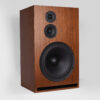Was perusing the SB Acoustics website for drivers and came across a new 3-way speaker design:

 sbacoustics.com
sbacoustics.com
Appears aimed at the market for those pining for the days of big woofers with wide baffle cabinets....

The drivers are all pretty reasonable however it uses a high part-count crossover that will drive the price a bit higher. Gema is marketed as part of SB's open-source effort so is more of a bare-bones approach vs their other more complete DIY kits. Nice to see support of DIY from a reputable supplier of contemporary speaker drivers.

Gema - Sbacoustics
Gema is a large 3-way speaker paying homage to the classic speaker of the 1970's. Generous enclosure proportions fitted with large bass drivers were the bee's knees at the time. And for good reason! The Gema is our take on a retro-styled speaker, and the much loved 12″ SB34NRXL75-8 lays the...
Appears aimed at the market for those pining for the days of big woofers with wide baffle cabinets....

The drivers are all pretty reasonable however it uses a high part-count crossover that will drive the price a bit higher. Gema is marketed as part of SB's open-source effort so is more of a bare-bones approach vs their other more complete DIY kits. Nice to see support of DIY from a reputable supplier of contemporary speaker drivers.
